Growing medicinal herbs in Ontario
Learn about crop production for medicinal herbs and some specific cultural requirements of more common varieties grown in Ontario.
ISSN 1198-712X, Published August 2023
Introduction
Over 4,000 medicinal herbs grow naturally or under cultivation in Canada, and many more could be grown in a greenhouse. In some cases, such as with traditional Chinese medicines, their use has been documented for over 2,000 years. The cultural requirements of medicinal herbs are often unique and specialized, making them a challenge to grow. Many of the herbs have had minimal breeding to overcome problems such as seed germination, consistency from plant to plant and adaptation to field or greenhouse conditions. Others are adapted to a forest environment and must be grown there or under artificial shade. In addition, some have developed close associations with organisms in a particular natural environment and may be very difficult to cultivate elsewhere.
This fact sheet is a companion to the Ministry of Agriculture, Food and Rural Affairs (OMAFRA) fact sheet Growing non-traditional crops in Ontario. It provides more detail on aspects of crop production specific to medicinal herbs and summarizes some of the specific cultural requirements of the more common medicinal herbs that can be grown in Ontario.
It is not the purpose of this fact sheet to list all the potential laws and regulations that govern the import, culture and sale of medicinal herbs in Ontario. It is the growers' responsibility to inform themselves of the legal requirements of their operation. A few examples of legislation that may be relevant to medicinal herb growers are listed in the Resources section at the end of this fact sheet. The Endangered Species Act in Ontario and the Natural Health Production Regulations are two examples of particular relevance to medicinal herb growers.
The Ministry of Natural Resources is responsible for administering the Endangered Species Act. Ginseng and goldenseal are examples of medicinal herbs currently listed, under the act, as endangered or threatened. As a result of their listing in the act, it may not be legal to grow or collect them in the wild, or special permits may be required to do so.
The Natural Health Product Regulations of Health Canada govern the manufacture and sale of all natural health products but not the culture of medicinal herbs. However, specific health claims for the end product, whether fresh, dried or processed, cannot be made verbally or in writing without a proper licence. These regulations are continually revised, so it is critical for growers to understand how changes in the regulatory framework impact their ability to produce and sell medicinal herbs.
Accurate plant identification by qualified experts is important, because some medicinal herbs are uncommon and others can be very harmful to human health if used improperly. Some medicinal herbs can be confused with poisonous species that share the same common name or have a similar appearance. Accurate plant identification is essential to ensure that growers know with confidence what they are growing.
The Saskatchewan Herb and Spice Association and the Canadian Herb, Specialty Agriculture and Natural Health Product Coalition have developed an online plant identification practice manual, Good Practices for Plant Identification for the Herbal Industry, that can help ensure proper identification and provide traceability documentation. Information on good agriculture and collection practices is available from the Canadian Herb Specialty Agriculture and Natural Health Products Coalition website.
Marketing
Medicinal herbs often have very specialized markets. These include farm gate, farmer's markets, herbal medicine practitioners and natural health product manufacturers. Some medicinal herbs are primarily for export. It is important to research where, when and if there is a market for the crop before committing to grow it.
While the timing, location and specific quality specifications of a market differ greatly, depending on the herb, in most cases, consistency of quality is the most important consideration for the sale of medicinal herbs. Often, the active medicinal components of the herb are affected by growing conditions, which are rarely constant. Changes in fertilization rates, water availability and pest pressure can influence both plant growth and chemical composition, possibly changing the levels of the desirable medically active components. Large natural health product manufacturers will require consistency to ensure every batch of their product has a similar concentration of active components.
General cultural requirements
The cultural requirements of medicinal herbs differ greatly, depending on the crop. Some of these requirements are summarized in the next section. Since not every medicinal herb can be listed, consider these general guidelines before growing any medicinal herb. Unlike most cultivated crops, there are few improved varieties of medicinal herbs available. However, different species within a genus may share the same common name. For example, there are several species of Echinacea, each with specific medicinal qualities and specific markets, so take care to ensure the species grown matches the intended market.
Labour
Labour requirements will typically be very high for medicinal herb production due to the lack of products and specialized technology that reduce labour requirements in traditional agriculture. The highest labour requirements are typically for planting, harvest, pest control and weed control.
Growing conditions
Whether a crop will perform well in a certain location often depends on the native habitat of the crop. For example, herbs native to the temperate climate of Northern Europe will require cool temperatures in summer and may require protection during the winter. For some crops, mimicking the native climate of the herb by growing it under artificial shade or in a controlled environment such as a greenhouse may be necessary. Consider whether the value of the crop will be high enough to warrant the extra cost of such structures. The native habitat of the herb can provide some hints as to its ideal soil type, water, drainage and light requirements. Frost protection such as row covers, mulches or fans may be necessary for some medicinal herbs.
Crop establishment
In many cases it can be very difficult to locate seeds for medicinal herb plantings. Contact the Canadian Food Inspection Agency to determine if a permit is required for importing seeds or transplants. Many laws govern the import of plants and plant products into Canada.
Many medicinal herb seeds have very specific requirements for germination. For example, after harvest, ginseng seeds require an 18-22 month stratification period involving cold, warm and cold periods in order to germinate. Some seeds require light to germinate, while others require darkness. Some seeds can be dried and stored for long periods of time, while others need to be kept moist and will only store for a few months. Angelica seeds, for example, can be very difficult to germinate unless they are harvested soon after maturity and seeded immediately. Scarification, a process of scratching to allow moisture to enter the seed, is required for some medicinal herbs.
In rare cases, seeds cannot be reliably germinated, and the plants must be grown from cuttings or division. Propagation from cuttings or plant division has the benefit of preserving the exact characteristics of the parent plant. Try experimenting on a small scale prior to establishing a large acreage of a medicinal herb.
Many medicinal herbs are perennials and will grow back year after year, reducing the challenges associated with planting. Be aware that some medicinal herbs may be perennials in their native habitat but must be grown as annuals in Ontario because they will not survive the winter.
Fertilization
It can be challenging to properly fertilize a medicinal plant. Nutrients that increase the growth of the plant do not necessarily increase the concentration of the medicinally active components. As the plant grows larger, the concentration of the medicinally active components can be diluted, resulting in a lower quality product.
However, certain types of compounds can be increased by increased fertilization. For example, phytochemicals linked to photosynthesis in the leaf can often increase with increasing nitrogen fertilizer, since nitrogen often causes darker green leaves that have a higher chlorophyll content. As a general rule, the plant will have higher amounts of medicinally active components if the fertilization results in soil fertility matching the plant's native habitat. This can only be considered a starting point, since there are numerous exceptions to this rule.
Pest control
Pest control is another major challenge to successful medicinal herb production. It is important to realize that pest problems typically increase over time and as the acreage of the crop increases. Pests may also be more of a problem if the crop is grown outside of its natural environment.
In some cases, crops cannot be grown successfully in Ontario due to pre-existing pests. For example, St. John's wort is difficult to grow commercially in Ontario due to canopy destruction by the Chrysolina beetle. The beetle was introduced in Ontario as a biological control for St. John's wort in the 1950s when it was first considered a problem weed in pastures, as grazing livestock can be poisoned.
Since there are rarely chemical or biological controls registered for use on medicinal herbs, and the marketplace often does not accept pesticide use, cultural controls will be necessary. Avoid growing the same medicinal herb or 2 closely related herbs in succession on the same site, as this often promotes the build-up of pests in the soil.
Harvest
Harvest practices for medicinal herbs are highly dependent on the plant part used, the medicinally active components that need to be maximized and the growth characteristics of the herb.
Unlike vegetables or culinary herbs, appearance alone does not often determine medicinal herb quality, and in some cases, appearance may not be important at all. Quality is primarily determined by the concentration of medicinally active components, which can only be determined using specialized laboratories, which can be very expensive. However, this information may only be required by large natural health product manufacturers.
Postharvest
Postharvest handling is highly dependent on the crop and the market. The end-use will often determine how the herb should be handled. Many medicinal herbs will be dried after harvest and stored for long periods of time. However, the quality of the product may degrade over time, even as a dried product.
Although medicinal herbs are often not considered food crops, food safety is still very important. As with food crops, there is the potential for food-borne illness to be spread on medicinal herbs, even if they are dried. A medicinal herb grower needs to take the same precautions as fruit or vegetable growers and follow all current regulations governing food safety.
It can be very difficult to distinguish different dried or processed medicinal herbs. It is essential to either process medicinal herbs in separate areas where there is little chance for cross-contamination, or thoroughly clean the processing area before switching to another herb. Label products soon after harvest to avoid any mistakes. Medicinal herbs have great potential for harmful interactions with other herbs or prescription drugs, and any cross-contamination could have major consequences.
Specific cultural requirements for medicinal herbs
Caution: Many medicinal herbs can be dangerous if used improperly even if they are listed as "culinary." Consult a physician, or any other recognized authority, before consuming any medicinal herb.
Yarrow (Achillea millefolium)
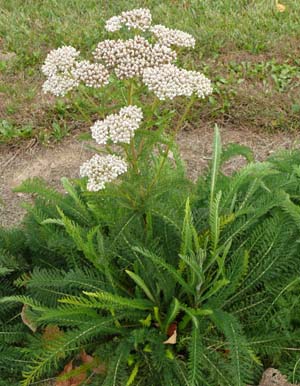
- Common names: yarrow, nosebleed, millefoil, thousand leaf, woundwort
- Traditional uses: internal and external medicine
- Origin: Northern Hemisphere
- Aspect: sun to partial shade
- Propagation: seed/division
- Soil type: all types/well-drained
- Plant parts used: leaves and flower
- In-row spacing: 20-30 cm
- Height: 30-90 cm
Yarrow is an erect, spreading perennial with deeply divided green leaves and flat clusters of white, pink or yellow flowers from mid-summer to fall. There are many different cultivars available. Most yarrow cultivars are invasive if left alone, as they can spread both by seed and by underground rhizomes. Yarrow is commonly found growing wild in North America. Leaves are harvested as the plant comes into flower.
Oxknee (Achyranthes bidentata)

Source: Shutterstock
- Common names: Niu Xi, two-toothed amaranthus, oxknee
- Traditional uses: culinary, internal medicine
- Origin: East Asia
- Aspect: partial shade
- Propagation: seed/division
- Soil type: well-drained
- Plant parts used: root, stem, leaves, seed
- In-row spacing: 25 cm
- Height: 80 cm
Achyranthes is an erect, tender perennial grown as an annual in Ontario with slender, rambling branches, elliptical leaves and greenish white flowers on terminal spikes. The seeds are a good substitute for cereal grains used in bread making. Leaves and stems are harvested in the summer, and roots are dug in late fall after the foliage has died back.
Black cohosh (Actaea racemosa (syn. Cimicifuga racemosa))
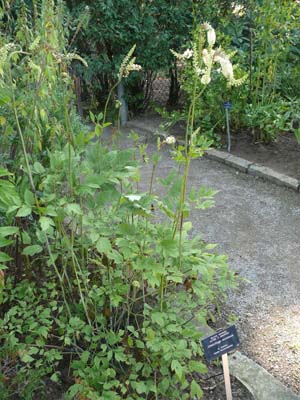
- Common names: black cohosh, black bugbane, black snakeroot, blue ginseng, bugbane
- Traditional uses: internal medicine
- Origin: Eastern North America
- Aspect: partial to full shade
- Propagation: seed
- Soil type: moist, well-drained
- Plant parts used: rhizomes
- In-row spacing: 60 cm
- Between row spacing: 90-120 cm
- Height: 150 cm
Black cohosh is an herbaceous perennial with large, compound leaves growing from a gnarled rhizome. A tall, slender spike with whitish or yellow flowers is produced in late spring and early summer. It is commonly found in open areas in woodlands. The rhizome and roots are harvested in the fall.
Agrimony (Agrimonia eupatoria)
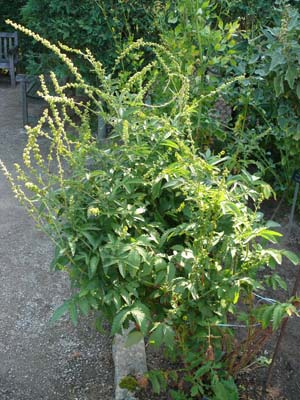
- Common names: agrimony, sticklewort, cocklebur, church steeples
- Traditional uses: culinary, external and internal medicine, dye
- Origin: Eurasia and North Africa
- Aspect: sun to partial shade
- Propagation: seed/division
- Soil type: moist
- Plant parts used: leaves, flower
- In-row spacing: 30 cm
- Height: 150 cm
Agrimony is a slightly aromatic perennial herb. Stems are cylindrical and slightly rough, bearing only a few branches. Leaves are downy green and made up of serrated leaflets arranged in large and small alternate pairs. Flowers are numerous, small and yellow, borne on long spikes. Agrimony plants are cut when they are flowering. Avoid any flower spikes that have started to develop sharp burrs. Seeds must be stratified for 6 weeks in order to germinate.
Marshmallow (Althaea officinalis)
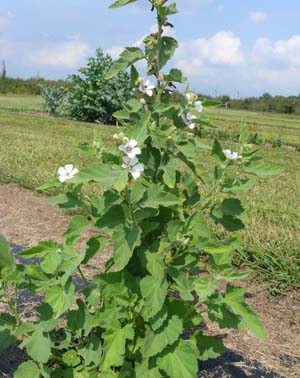
- Common names: marshmallow, mortification root, sweet weed, wymote, marsh malice
- Traditional uses: culinary, internal and external medicine
- Origin: Africa
- Aspect: full sun
- Propagation: seed/stem cuttings/division
- Soil type: rich, moist, well-drained
- Plant parts used: root, leaves, flower
- In-row spacing: 45 cm
- Between row spacing: 60-75 cm
- Height: 60-150 cm
Marshmallow is a perennial with an erect habit, woody taproot and woolly stem. Leaves are alternate and greyish-green in colour, with star-shaped hairs on both sides. The lower leaves are toothed, circular in shape with 3-5 lobes. Upper leaves are ovate to lanceolate, pointed, lobed and toothed. Pink or white flowers with 5 notched petals are borne on the upper leaf axils. Roots are usually harvested in the fall of the second year.
European angelica (Angelica archangelica)

- Common names: European angelica, garden angelica, root of the Holy Ghost
- Traditional uses: culinary, internal medicine, industrial, dye
- Origin: Northern Europe
- Aspect: partial shade
- Propagation: seed/division
- Soil type: rich, moist
- Plant parts used: stem, leaves
- In-row spacing: 30 cm
- Between row spacing: 60-90 cm
- Height: 150-240 cm
Angelica is an aromatic biennial or short-lived perennial plant with upright, ridged, hollow stems and bright green, large, pinnate leaves. Flowers are small, white or greenish in globe-shaped compound umbels. There is not a large market for this plant. The majority of angelica grown abroad is used to produce essential oil. Angelica should be harvested in early autumn. Harvested roots should be dried at 38-60°C.
Dang gui (Angelica sinensis)
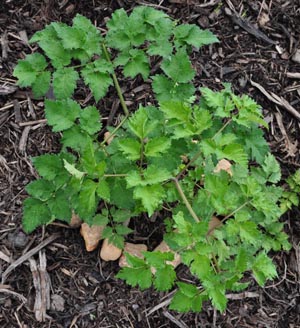
- Common names: Chinese angelica, dang gui, women's angelica
- Traditional uses: culinary; internal, aromatic and external medicine
- Origin: China
- Aspect: sun to partial shade
- Propagation: seed
- Soil type: rich, moist
- Plant parts used: root, leaves
- In-row spacing: 30 cm
- Between row spacing: 60-90 cm
- Height: 200 cm
Chinese angelica is an erect perennial with large, bright green, divided leaves and hollow stems that bears umbels of small white flowers in early summer. Angelica can be confused with water hemlock (Oenanthe crocata), which is poisonous. Roots should be harvested in the fall of the second year.
Yellow chamomile (Anthemis tinctoria)
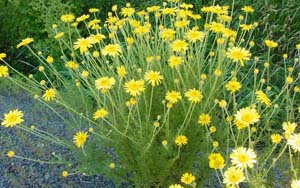
- Common names: yellow chamomile, golden marguerite, dyer's chamomile
- Traditional uses: internal and external medicine, dye
- Origin: Eurasia
- Aspect: full sun
- Propagation: seed/division
- Soil type: moist
- Plant parts used: leaves, seed
- In-row spacing: 20-60 cm
- Height: 60 cm
Yellow chamomile, a short-lived perennial, has bright green, pungent, finely divided, feathery leaves, and yellow, daisy-like flowers that are borne singly on long, thin stems. The plant cannot survive extreme heat or drought. Leaves are harvested in spring and early summer. Flowers are harvested in full bloom.
Japanese burdock (Arctium lappa)
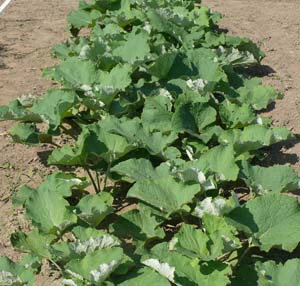
- Common names: Japanese burdock, beggar's buttons, lappa, gobo, burdock, burrseed
- Traditional uses: culinary, internal medicine
- Origin: Eurasia
- Aspect: full sun
- Propagation: seed
- Soil type: rich
- Plant parts used: root
- In-row spacing: 15 cm
- Between row spacing: 60-90 cm
- Height: 150 cm
Japanese burdock is a biennial plant with large leaves that are dark green on the top and downy grey on the bottom. Flowers are purple and thistle-like, with hooked bracts (burrs). Roots are usually harvested in the early fall of the first year or in the spring of the second year. Old roots become pithy and bitter. The roots are long (up to 1 m) and may require specialized harvest equipment. Some growers cultivate in beds mixed with wood chips or sawdust to loosen the soil. Japanese burdock roots can be confused with the poisonous roots of deadly nightshade (Atropa belladonna).
Arnica (Arnica montana)
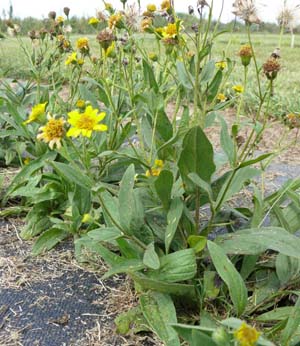
- Common names: arnica, mountain tobacco, leopard's bane, wolfsbane
- Traditional uses: internal and external medicine
- Origin: Eurasia and North America
- Aspect: full sun
- Propagation: seed/division
- Soil type: sandy, acidic, rich
- Plant parts used: root, leaves
- In-row spacing: 30 cm
- Height: 30-60 cm
Arnica is a perennial with single yellow flowers blooming all summer long. Leaves are light green, hairy and oval. It can be found growing wild in mountainous regions. Flowers and leaves are picked in mid-summer before full bloom. Roots can be dug in the second or third year of growth in the late fall.
Milkvetch (Astragalus membranaceous)
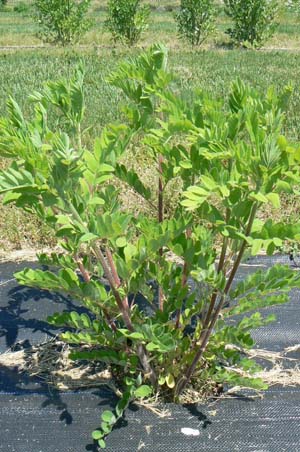
- Common names: milkvetch, huang qi, Chinese milkvetch
- Traditional uses: internal medicine
- Origin: China and Mongolia
- Aspect: full sun
- Propagation: seed
- Soil type: sandy, well-drained
- Plant parts used: root
- In-row spacing: 45-60 cm
- Height: 40 cm
Astragalus is a perennial with hairy stems and pinnate leaves made up of 12-18 pairs of leaflets. Roots are harvested in the fall after three or more years of growth.
Borage (Borago officinalis)
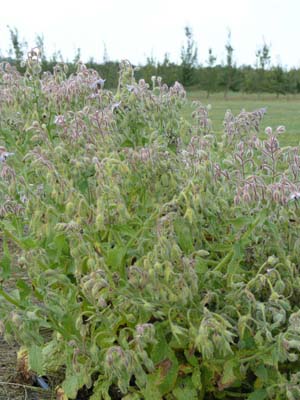
- Common names: borage, bugloss
- Traditional uses: culinary, internal and external medicine
- Origin: Mediterranean
- Aspect: full sun
- Propagation: seed
- Soil type: sandy, poor
- Plant parts used: leaves, flower
- In-row spacing: 60 cm
- Height: 60 cm
Borage is an upright annual with hollow, bristle-covered branches, oblong leaves and star-shaped purple flowers that bloom from early summer to fall. Borage is now found growing wild in North America. It is best grown directly from seed. Flowers and leaves can be collected throughout the summer.
Blue cohosh (Caulophylum thalictroides)
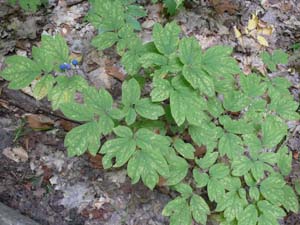
- Common names: blue cohosh, blueberry root, blue ginseng
- Traditional uses: internal medicine
- Origin: North America
- Aspect: shade
- Propagation: root
- Soil type: rich, moist, loam
- Plant parts used: root
- In-row spacing: 30-40 cm
- Height: 90 cm
Blue cohosh is a woodland perennial native to hardwood forests. It bears two- or three-lobed leaves with a tall stem with yellowish-green to maroon flowers in spring. Blue berries are produced after flowering. Rhizomes are harvested in the fall, winter or early spring.
False unicorn (Chamaelirium luteum)
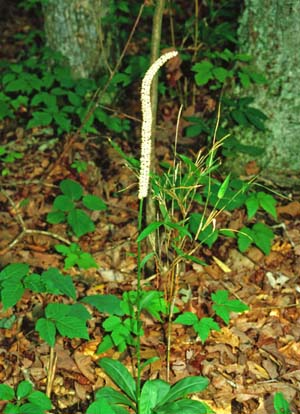
- Common names: false unicorn, fairywand, blazing star, devil's bit, grub root
- Traditional uses: internal medicine
- Origin: North America
- Aspect: shade to partial shade
- Propagation: seed/division
- Soil type: moist, acidic, well-drained
- Plant parts used: root
- In-row spacing: 15-25 cm
- Height: 60 cm
False unicorn is a perennial native to wet areas in mixed or open woodlands. A flower spike is sent up from a rosette of smooth, lance-shaped evergreen leaves. White male and green female flowers are produced on separate plants. Female plants are leafier than the male plants. Roots are harvested in the fall after 6-10 years.
Celandine (Chelidonium majus)
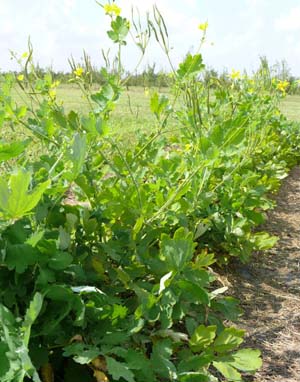
- Common names: celandine, swallow wort, tetter wort
- Traditional uses: internal and external medicine
- Origin: Eurasia
- Aspect: sun to partial shade
- Propagation: seed/division
- Soil type: rich, moist
- Plant parts used: leaves
- In-row spacing: 20-45 cm
- Height: 45 cm
Celandine is a variable biennial or perennial with a thick, multi-branched taproot. Yellow-green, pinnate leaves are made up of pairs of oblong leaflets and a large terminal leaflet. Stems are brittle, and both stem and damaged leaves exude an orange sap, which will stain clothes. Flowers are yellow, with 4 petals. Celandine has naturalized in parts of North America. This herb is subject to legal restrictions in some countries and if used in excess can cause sleepiness, skin irritation, irritant coughing and difficulty breathing. The plant requires regular watering. Above-ground parts are harvested in the spring or early summer.
Wild yam (Dioscoria villosa)
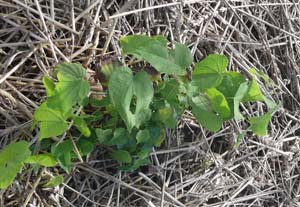
- Common names: wild yam, Atlantic yam, China root, devil's bones
- Traditional uses: internal and external medicine
- Origin: North America
- Aspect: partial shade
- Propagation: root cuttings/tubercles (tuber-like growths produced at the leaf axils)
- Soil type: moist, most types
- Plant parts used: root
- In-row spacing: N/A
- Height: 270-450 cm
Wild yam is a perennial vine that grows on roadsides and forest edges. It has glossy, heart-shaped leaves, tiny green/yellow flowers and a triangular fruit capsule. Slender rhizomes are harvested in fall, and the plant is harvested in the summer at full bloom.
Purple coneflower (Echinacea spp.)
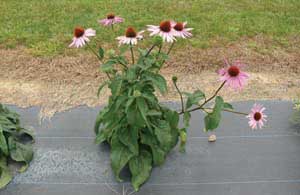
- Common names: Echinacea, purple coneflower, hedgehog
- Traditional uses: internal and external medicine
- Origin: North America
- Aspect: sun to partial shade
- Propagation: seed/division
- Soil type: well-drained
- Plant parts used: root, leaves
- In-row spacing: 45-90 cm
- Height: 60-90 cm
Echinacea species are upright perennials with alternate, lance-shaped leaves and prominent white to purple flowers blooming from mid-summer to fall. There are several species used medicinally with E. purpurea and E. angustifolia being the most common. E. angustifolia is considered to be higher in medicinal quality but is also much more difficult to grow. While roots, leaves and flowers can be used, the root has the most uses. Roots are harvested in the fall, while leaves and flowers are harvested at bloom.
Dyer’s broom (Genista tinctoria)
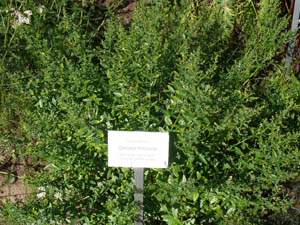
- Common names: dyer's broom, dyer's greenweed, Genista broom
- Traditional uses: internal medicine, dye
- Origin: Eurasia
- Aspect: full sun
- Propagation: seed/stem cuttings
- Soil type: sandy, well-drained
- Plant parts used: leaves, stem
- In-row spacing: 90-120 cm
- Height: 60-100 cm
Dyer's broom is a deciduous shrub with leaves that are narrow, bright green and about 2.5 cm long. Yellow flowers are borne in spikes and resemble pea flowers. Leafy branches should be cut before seed has set. The dried herb has a 1-year shelf-life.
Goldenseal (Hydrastis canadensis)
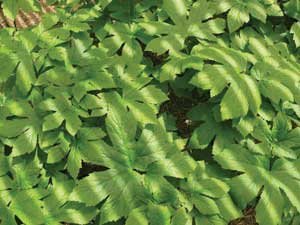
- Common names: goldenseal, eyebalm, eyebright, turmeric
- Traditional uses: internal and external medicine, insect repellent
- Origin: North America
- Aspect: shade
- Propagation: seed/root cuttings
- Soil type: rich, moist, well-drained
- Plant parts used: root
- In-row spacing: 6 cm
- Between row spacing: 6-12 cm
- Height: 15-45 cm
Goldenseal is a perennial native to hardwood forests. It is considered an endangered species in the wild, and its culture and collection are governed by the Endangered Species Act in Ontario. It produces a single stem with 2 5-7-lobed leaves and a greenish white flower. The flower eventually produces a raspberry-like fruit that is inedible. The roots are harvested in the fall after several years of growth, and leaves are harvested in the fall after the seeds ripen. Collecting goldenseal roots, leaves or seeds from the wild is illegal in Ontario.
St. John’s wort (Hypericum perforatum)
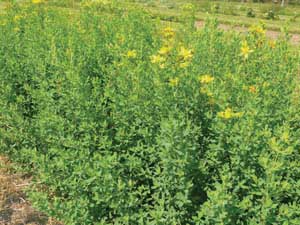
- Common names: St. John's wort, warriors wound, amber, touch and heal
- Traditional uses: internal and external medicine
- Origin: Europe
- Aspect: full sun
- Propagation: seed
- Soil type: rich, moist
- Plant parts used: leaves, flower
- In-row spacing: 15-30 cm
- Between row spacing: 40 cm
- Height: 80 cm
St. John's wort is a perennial with small stalkless leaves covered with tiny holes and scented yellow flowers in summer. It spreads by numerous underground rhizomes. It now grows naturally in North America and is considered a problem weed in pastures, as grazing livestock can be poisoned. On a larger scale, production is limited by the Chrysolina beetle. Leaves and flowers can be harvested as required.
Hyssop (Hyssopus officinalis)
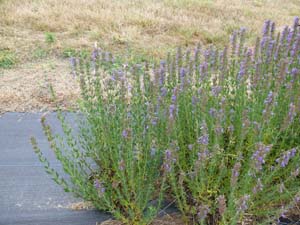
- Common names: hyssop
- Traditional uses: culinary, internal and external medicine
- Origin: Mediterranean
- Aspect: full sun
- Propagation: seed/stem cuttings
- Soil type: dry, all
- Plant parts used: leaves
- In-row spacing: 30-45 cm
- Height: 90 cm
Hyssop is a semi-evergreen perennial with small, narrow, aromatic, lance-shaped leaves and white, pink or blue flowers from summer to early autumn. It can occasionally be found growing wild in North America. Young leaves and flowers are harvested in summer.
Elecampane (Inula helenium)
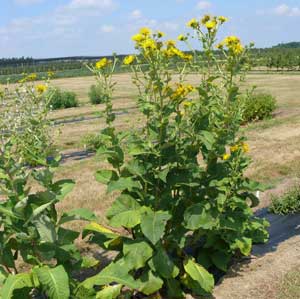
- Common names: elecampane, July campane, dock, wild sunflower, yellow starwort
- Traditional uses: culinary, internal and external medicine, cut flower, dye, aromatic
- Origin: Asia
- Aspect: full sun
- Propagation: seed/division
- Soil type: moist, well-drained, clay loam
- Plant parts used: root, flower
- In-row spacing: 30-45 cm
- Between row spacing: 60-75 cm
- Height: 90-180 cm
Elecampane is a perennial with a strong, round, coarse, woolly stem and pointed and slightly toothed leaves growing 30-60 cm long, with a bristly upper surface and velvety under surface. Flowers are yellow and daisy-like. Elecampane has spread across Western Europe to North America. The root is dug in the fall, used fresh for extracts or syrup, or dried for decoctions, liquid extracts, tinctures or powders. Flower heads are picked at full bloom and dried whole for infusions and powders. Flowers contain irritant fibres and should be prepared using a muslin bag.
Lovage (Levisticum officinale)
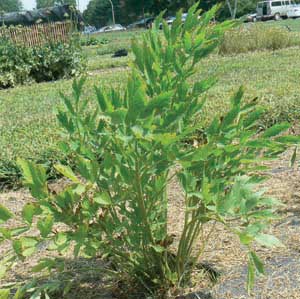
- Common names: lovage, love parsley, sea parsley, lavose, smallage
- Traditional uses: culinary, internal and external medicine, aromatic
- Origin: Middle East
- Aspect: sun to partial shade
- Propagation: seed/division
- Soil type: rich, well-drained
- Plant parts used: root, stem, leaves
- In-row spacing: 40-50 cm
- Between row spacing: 60-100 cm
- Height: 200 cm
Lovage is a hardy perennial herb, with ribbed stalks similar to celery, and hollow stems that divide into branches near the top. Yellow flowers are borne in compound umbels, about 30 mm across. Leaves are dark green, opposite and compound. Leaflets are wedge shaped and may be toothed or ridged. The major area of production is in central Europe. An essential oil can be extracted from the seeds (0.8-1.1%), roots (0.6-1.0%) and leaves (0.05-0.15%). Lovage is winter hardy, and mulching assists winter survival. Leaves are usually harvested twice a season, starting in the second year. Stems are cut in spring. Roots are dug in the fall of the third year and can be used fresh or dried.
German chamomile (Matricaria recutita)
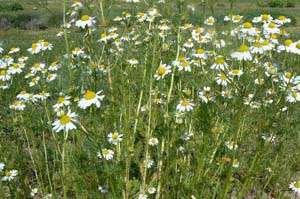
- Common names: German chamomile, scented mayweed
- Traditional uses: culinary, internal medicine, personal hygiene products
- Origin: Mediterranean
- Aspect: full sun
- Propagation: seed
- Soil type: well-drained
- Plant parts used: flower
- In-row spacing: 15-30 cm
- Height: 60 cm
German chamomile is an annual herb with erect, light green, smooth, multi-branched stems and finely divided, feathery leaves. Flowers are daisy-like, small with a yellow, solitary, central disk and white ray flowers along the edge. An essential oil (0.3-1.3% fresh weight) can be extracted from the flower heads. There has been extensive plant breeding and cultivars with high yields and specific essential oil qualities have been developed. Although it is drought tolerant, plenty of water is required for germination and development of young plants. Flower heads are harvested in the summer while in full bloom. Volatile oils are lost rapidly upon drying. German chamomile can yield 340-560 kg of dried flowers per hectare.
Lemon balm (Melissa officinalis)
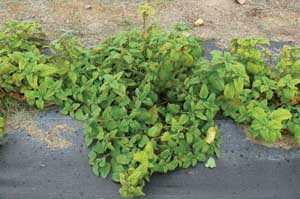
- Common names: lemon balm, Melissa, bee balm, cure all, dropsy plant
- Traditional uses: culinary, internal and external medicine, aromatherapy, personal hygiene products
- Origin: Southern Europe
- Aspect: sun or partial shade
- Propagation: seed/stem cuttings/division
- Soil type: moist, well-drained
- Plant parts used: leaves
- In-row spacing: 30-45 cm
- Between row spacing: 60-75 cm
- Height: 150 cm
Lemon balm is an herbaceous perennial with opposite, broad, ovate, toothed, lemon-scented leaves, and clusters of small, white or yellowish, tubular flowers. Lemon balm was known to the ancient Greeks, Romans and Arabs as a medicinal plant. It has been cultivated in the Mediterranean for about 2,000 years. An essential oil (0.1-0.8% fresh weight) can be extracted. Most commercial production is located in the Mediterranean. Plants should be cut as flowering begins by removing the top growth, leaving 5 cm of stubble for re-growth. Lemon balm is susceptible to frost, and mulching is recommended before a hard frost.
Pennyroyal (Mentha pulegium)
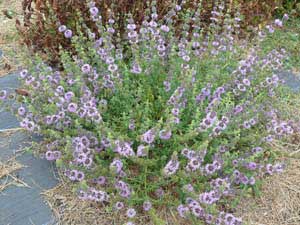
- Common names: pennyroyal, pudding grass
- Traditional uses: culinary, internal and external medicine, insect repellent
- Origin: Europe and North Africa
- Aspect: full sun
- Propagation: seed/division
- Soil type: all types
- Plant parts used: leaves, stem
- In-row spacing: 15-30 cm
- Height: 10-45 cm
Pennyroyal is a creeping semi-evergreen perennial with glossy dark green leaves that have a strong peppermint smell and small mauve flowers in late spring. As the plant creeps along the ground, new roots are produced along the stem. The plant can become invasive if not kept under control. If winters are wet and cold, pennyroyal may not overwinter consistently. Leaves are picked as required for medicinal use.
Catnip (Nepeta cataria)
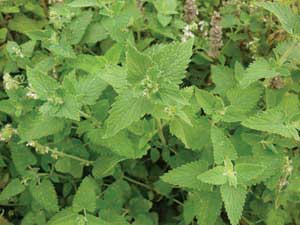
- Common names: catnip, catmint, field balm, dog mint
- Traditional uses: culinary, internal and external medicine, cat products, mice repellent
- Origin: Europe
- Aspect: full sun
- Propagation: seed/stem cuttings/division
- Soil type: all types
- Plant parts used: leaves, stem
- In-row spacing: 22-30 cm
- Between row spacing: 75-90 cm
- Height: 45-90 cm
Catnip is an erect perennial with square, branched, woolly stems. Leaves are heart shaped with greyish-green, downy undersides and toothed edges. Flowers are tubular, white with purple-pink spots and are arranged in dense whorls on spikes. Japanese catnip, Schizonepeta tenuifolia is closely related to Nepeta cataria. Catnip can be found growing wild in Ontario. The plant was known to Roman cooks and doctors and went with European settlers wherever they went. Catnip got its name from its well-known reputation for attracting cats. There is a limited market for this plant. It is harvested in late summer during full bloom. It is harvested once in the first year and twice a year after that. At least 7 cm of stubble are left after harvest. The yield can be 3,400-4,500 kg/ha. It is dried in the field, by hanging or by heating at 40°C. Volatile oils will deteriorate under improper drying conditions.
Evening primrose (Oenothera biennis)
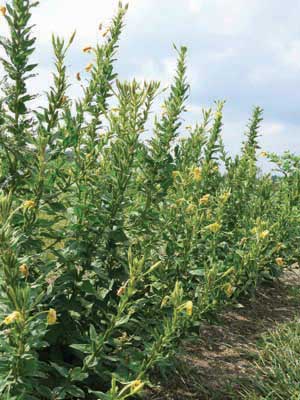
- Common names: evening primrose, night willow herb, evening star, fever plant
- Traditional uses: internal and external medicine
- Origin: North America
- Aspect: full sun
- Propagation: seed
- Soil type: sandy, well-drained
- Plant parts used: leaves, stem, seed
- In-row spacing: 7.5 cm
- Height: 20 cm
Evening primrose is a biennial plant with numerous, crinkled, lance-shaped leaves and green stems with red splotches. Flowers bloom after sunset and are yellow, fragrant with four broad petals. Bloom is continuous from June through autumn. First-year plants are a spreading rosette. This plant is grown commercially for its seed oil. Seeds are collected when ripe and pressed for oil. Seeds should contain 30-40% moisture.
Madder (Rubia tinctorum)
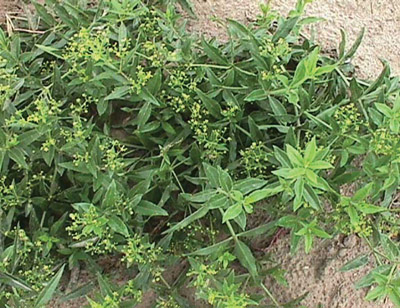
- Common name: madder
- Traditional uses: internal medicine, dye
- Origin: Mediterranean
- Aspect: sun/partial shade
- Propagation: seed/division
- Soil type: loam, well-drained
- Plant parts used: root
- In-row spacing: N/A
- Height: 120-150 cm
Madder is a perennial plant with slender, slightly square, jointed stems that are covered with short prickles allowing the plant to climb. Leaves have prickly margins and midribs and are arranged in circles of 4 to 6 around the stem. Flowers are small, greenish white to pale yellow and slightly bell-shaped. Lift rhizomes and roots from 3-year-old plants in the autumn. Roots should be peeled and dried. For Chinese medicine, roots are lifted in the spring. Roots for dying can be lifted in the spring or fall.
Skullcap (Scutellaria laterifolia)
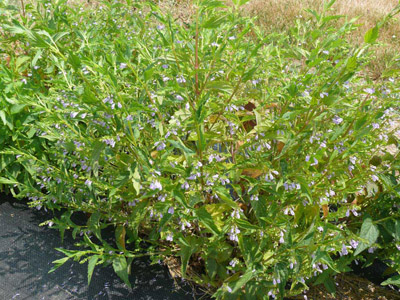
- Common names: skullcap, helmet flower, mad dog weed, blue pimpernel
- Traditional uses: internal medicine
- Origin: North America
- Aspect: sun to partial shade
- Propagation: seed/division
- Soil type: moist, well-drained
- Plant parts used: leaves, flower
- In-row spacing: 15-30 cm
- Height: 20-45 cm
Skullcap is an upright perennial with bright green, lance-shaped leaves with rounded teeth and inconspicuous or showy purple flowers in summer. Do not let skullcap dry out. Flowers and leaves can be harvested as required.
Feverfew (Tanacetum parthenium)
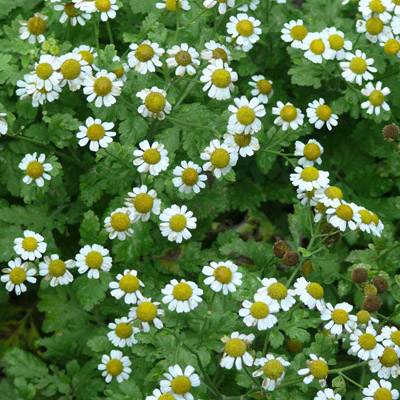
- Common names: feverfew, febrifuge
- Traditional uses: internal medicine
- Origin: Southeastern Europe
- Aspect: full sun
- Propagation: seed/stem cuttings/division
- Soil type: rich, loam, well-drained
- Plant parts used: stem, leaves, flower
- In-row spacing: 30-38 cm
- Between row spacing: 60 cm
- Height: 60 cm
Feverfew is an herbaceous perennial with yellow-green, pinnately lobed leaves and numerous daisy-like flower heads. Feverfew has been used for hundreds of years as a medicinal plant. Parthenolide is the active chemical and is found in glands on the leaves. If flowers are not harvested, feverfew will self-seed and can become invasive. Whole plants are harvested when flowering is at its peak. Leaves are harvested as required and used fresh or dried.
Valerian (Valeriana officinalis)
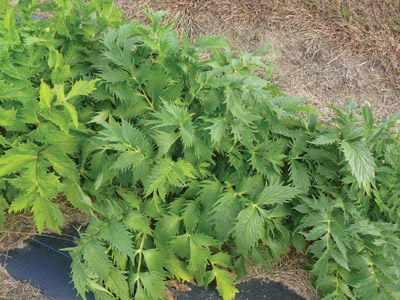
- Common names: valerian, all heal, set all, cut finger, St. George's herb
- Traditional uses: internal medicine
- Origin: Eurasia
- Aspect: full sun
- Propagation: root cuttings
- Soil type: rich, well-drained
- Plant parts used: root
- In-row spacing: 30-45 cm
- Height: 90 cm
Valerian is an upright perennial with pale green, long slender leaves and pink or white flower heads in summer. It can be found growing wild in North America. Roots should be dug in the fall of the second or third years. The small fibrous roots should be removed.
Vervain (Verbena officinalis)
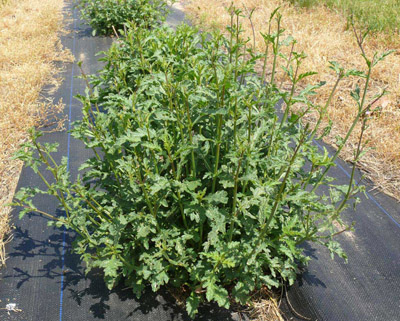
- Common names: vervain, holy herb, simpler's joy, pigeon's grass, burvine
- Traditional uses: internal medicine
- Origin: Mediterranean
- Aspect: full sun
- Propagation: seed/division
- Soil type: well-drained
- Plant parts used: leaves
- In-row spacing: 30 cm
- Height: 60-90 cm
Vervain is an upright perennial with hairy, green, divided leaves and pale purple flowers in summer. It can be found growing wild in many temperate regions. Leaves can be harvested as required, and whole plants should be cut when in bloom.
References
- Bisset, N.G. 1994. Herbal drugs and phytopharmaceuticals. CRC Press.
- Bown, D. 1995. Encyclopedia of herbs and their uses. RD Press.
- Bremness, L. 1994. Herbs. Dorling Kindersley Ltd. London.
- Chevallier, A. 1996. The encyclopedia of medicinal plants. Reader's Digest Association.
- Anonymous. 1998. Chinese herbal medicine. Shambhala Publications Inc.
- Foster, S., J.A. Duke. 1990. Eastern/central medicinal plants. Houghton Mifflin. New York.
- Jacobs, B. 1981. Growing & using herbs successfully. Pownal.
- Halva, S., L.E. Craker. 1996. Manual for northern herb growers. HSMP Press.
- Keville, K. 1994. Herbs, an illustrated encyclopedia. New York.
- Kowalchik, C., W.H. Hylton, eds. 1998. Rodale's illustrated encyclopedia of herbs. Rodale Press.
- Krochmal, A., C. Krochmal. 1984. A field guide to medicinal plants. Times Books, New York.
- McVicar, J. 1998. Jekka's complete herb book. Raincoast Books, Vancouver, British Columbia.
- Ody, P. 2000. Natural health complete guide to medicinal herbs. Dorling Kindersley, New York.
- Reid, D.P. 1986. Chinese herbal medicine. Shambhala Publications Inc. Boston, Mass.
- Richters herb catalogue. 1998.
- Saskatchewan Herb and Spice Association. 2000. Saskatchewan herb and spice production manual.
- Small, E. 1997. Culinary herbs. National Research Council of Canada. Ottawa.
- Sturdivant, L., T. Blakely. 1999. Medicinal herbs in the garden, field & marketplace. San Juan Naturals.
Resources
Technical information and advice is available from the Agricultural Information Contact Centre or by phone at
OMAFRA has many resources on crop production, business development, food safety and food processing. They can be found on the OMAFRA website.
Other resources include:
- Canadian Herb, Spice and Natural Health Product Coalition (plant identification manual)
- Canadian Health Food Association
- Ontario Herbalists Association
- Natural Health Product Research Society
Legislation
The following is not necessarily a complete or current list of all applicable legislation governing the production of a medicinal herb crop in Ontario. It is the grower's responsibility to be aware of all governing laws.
Federal legislation
Federal legislation can be found at the Canadian Department of Justice website.
- Health Canada (Pest Management Regulatory Agency)
- Natural Health Products Regulations
- Pest Control Products Act
- Canadian Food Inspection Agency
- Canada Agricultural Products Act
- Fertilizers Act
- Food and Drug Act
- Plant Protection Act
- Seeds Act
- Environment Canada
- Canadian Environmental Protection Act
- Wild Animal and Plant Protection and Regulation of International and Interprovincial Trade Act (WAPPRIITA)
Provincial acts
Ontario legislation can be found at Service Ontario's e-Laws.
- OMAFRA
- Weed Control Act
- Ministry of Natural Resources
- Endangered Species Act
This fact sheet is for informational purposes only. It was authored by Sean Westerveld, ginseng and medicinal herbs specialist, OMAFRA, Simcoe. The medicinal herb culture information was originally written by Jan Schooley, former ginseng and medicinal herbs specialist, OMAFRA. It was based on information collected from the demonstration garden of Dr. Alan McKeown, University of Guelph. The demonstration garden was made possible with grants from the Ontario Fruit and Vegetable Growers Association and the Tobacco Diversification Program.